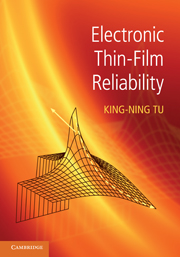Book contents
- Frontmatter
- Dedication
- Contents
- Preface
- 1 Thin-film applications to microelectronic technology
- 2 Thin-film deposition
- 3 Surface energies
- 4 Atomic diffusion in solids
- 5 Applications of the diffusion equation
- 6 Elastic stress and strain in thin films
- 7 Surface kinetic processes on thin films
- 8 Interdiffusion and reaction in thin films
- 9 Grain-boundary diffusion
- 10 Irreversible processes in interconnect and packaging technology
- 11 Electromigration in metals
- 12 Electromigration-induced failure in Al and Cu interconnects
- 13 Thermomigration
- 14 Stress migration in thin films
- 15 Reliability science and analysis
- Appendix A A brief review of thermodynamic functions
- Appendix B Defect concentration in solids
- Appendix C Derivation of Huntington's electron wind force
- Appendix D Elastic constants tables and conversions
- Appendix E Terrace size distribution in Si MBE
- Appendix F Interdiffusion coefficient
- Appendix G Tables of physical properties
- Index
- References
2 - Thin-film deposition
Published online by Cambridge University Press: 05 July 2014
- Frontmatter
- Dedication
- Contents
- Preface
- 1 Thin-film applications to microelectronic technology
- 2 Thin-film deposition
- 3 Surface energies
- 4 Atomic diffusion in solids
- 5 Applications of the diffusion equation
- 6 Elastic stress and strain in thin films
- 7 Surface kinetic processes on thin films
- 8 Interdiffusion and reaction in thin films
- 9 Grain-boundary diffusion
- 10 Irreversible processes in interconnect and packaging technology
- 11 Electromigration in metals
- 12 Electromigration-induced failure in Al and Cu interconnects
- 13 Thermomigration
- 14 Stress migration in thin films
- 15 Reliability science and analysis
- Appendix A A brief review of thermodynamic functions
- Appendix B Defect concentration in solids
- Appendix C Derivation of Huntington's electron wind force
- Appendix D Elastic constants tables and conversions
- Appendix E Terrace size distribution in Si MBE
- Appendix F Interdiffusion coefficient
- Appendix G Tables of physical properties
- Index
- References
Summary
Introduction
Thin-film deposition can be regarded as a phase change from a gas phase to a solid phase on a substrate [1, 2]. Typically, we need to know the growth rate, the purity, and the microstructure of the deposited film. The growth rate is controlled by the flux equation, to be discussed in the next section. For a high-purity film, it will require ultrahigh vacuum deposition, to be discussed in Section 2.7. The consideration of microstructure of the film, e.g. whether it is amorphous, polycrystalline, or epitaxial single crystal, will require specification of the deposition conditions or the selection of deposition parameters to be discussed in Section 2.11.
Fig. 2.1 depicts the two key parts in a vacuum chamber in film deposition; they are the target and the substrate. Let us assume that they are of the same material. The target is kept at temperature T1 and the substrate is kept at temperature T2, and T2< T1. At the equilibrium condition, there are fluxes of atoms departing from and returning to the target surface, as there are on the substrate surface on the basis of the principle of micro-reversibility. These fluxes establish an equilibrium pressure, P1 and P2, on the target and the substrate surfaces, respectively, and P2< P1. Due to the pressure difference or pressure gradient, it will lead to a flow of gas or mass transport via the gas state from the target to the substrate.
- Type
- Chapter
- Information
- Electronic Thin-Film Reliability , pp. 14 - 29Publisher: Cambridge University PressPrint publication year: 2010



